Did you know that over 70% of early settlements in the Philippines were established near freshwater sources? These natural lifelines, including rivers and lakes, played a pivotal role in shaping the archipelago’s pre-colonial societies. They provided not only drinking water but also fertile lands for agriculture, making them the heart of thriving communities.
Rivers are natural streams of freshwater that flow toward larger bodies like oceans or lakes. Their steady supply of water and nutrient-rich soil allowed early Filipinos to cultivate crops and sustain their way of life. Beyond survival, these waterways became hubs for trade, communication, and cultural exchange.
In the pre-colonial era, rivers were more than just resources—they were symbols of life and unity. Communities, known as barangays, often formed along their banks, fostering social and economic growth. Understanding their role offers a glimpse into the rich history and resilience of early Philippine civilizations.
Key Takeaways
- Rivers were essential for freshwater and agriculture in pre-colonial Philippines.
- Early settlements, or barangays, thrived near these natural waterways.
- Rivers facilitated trade and cultural exchange among communities.
- They played a symbolic role in uniting early societies.
- Understanding their significance reveals the resilience of pre-colonial Filipinos.
Historical Role of Rivers in Shaping Culture
Waterways have long been the backbone of civilizations, shaping trade, culture, and spirituality. In the pre-colonial Philippines, these natural highways connected communities, enabling the exchange of goods and ideas. They were more than just resources—they were the lifeblood of early societies.
Trade and Transportation in Early Societies
Waterways served as natural highways for trade and travel. Early Filipino communities relied on them to transport goods like rice, pottery, and textiles. This network linked barangays, fostering economic growth and cultural exchange.
Globally, rivers like the Nile and Tigris-Euphrates played similar roles. The Nile’s annual flooding enriched the land, supporting agriculture and trade. Similarly, the Tigris-Euphrates delta became a hub for commerce in Mesopotamia.
In the Philippines, proximity to water sources like the ocean and delta allowed communities to establish trade centers. These locations became vital for moving goods and people, creating a thriving network of commerce.
Cultural and Spiritual Connections with Waterways
Waterways held deep spiritual significance. Early Filipinos believed in river deities and performed rituals to honor them. These practices reflected their reverence for nature and its life-giving properties.
For example, the Ganges River in India is considered sacred, used daily for bathing and religious ceremonies. Similarly, the Nile was worshipped as a source of fertility and abundance.
| Civilization | River | Role |
|---|---|---|
| Ancient Egypt | Nile | Agriculture, Trade, Spirituality |
| Mesopotamia | Tigris-Euphrates | Commerce, Cultural Exchange |
| Pre-Colonial Philippines | Various Waterways | Trade, Transportation, Rituals |
Understanding these connections reveals how waterways shaped not just economies but also the cultural fabric of societies. To learn more about the infrastructure legacy in the Philippines, visit this detailed resource.
Geographical Features and Anatomy of a River
The anatomy of a river reveals its journey from source to mouth, shaping landscapes and ecosystems. Every river has distinct features that define its path and purpose. Understanding these elements helps us appreciate their role in nature and human life.
Sources, Courses, and Mouths
A river begins at its source, often called headwaters. These can be springs, glacial melt, or rainfall runoff. For example, the Nile starts from Lake Victoria in East Africa. From there, it flows through diverse terrains, shaping its course.
As it moves, smaller streams and tributaries join the main river. This merging point is called a confluence. The Mississippi River, for instance, grows larger as it collects water from its many tributaries. This process creates a powerful flow that shapes the land.
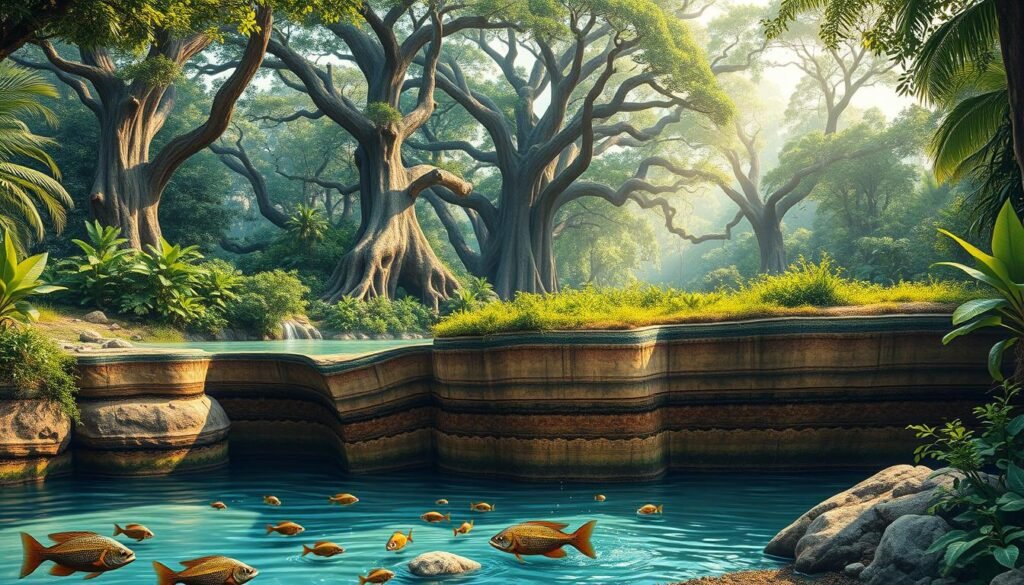
The journey ends at the river’s mouth, where it meets a larger body of water like an ocean or lake. The Nile empties into the Mediterranean Sea, forming a fertile delta. This transition point is crucial for ecosystems and human settlements.
Rivers are dynamic systems. Their anatomy includes headwaters, courses, confluences, and mouths. Each part plays a vital role in shaping the environment. By studying these features, we gain insight into their importance and impact.
Rivers and Their Impact on the Landscape
Flowing water has shaped the Earth’s surface for millions of years, carving valleys and depositing fertile soils. From headwaters to deltas, these natural forces have created some of the most iconic landscapes in the world. Understanding their processes reveals how they continue to influence our environment.
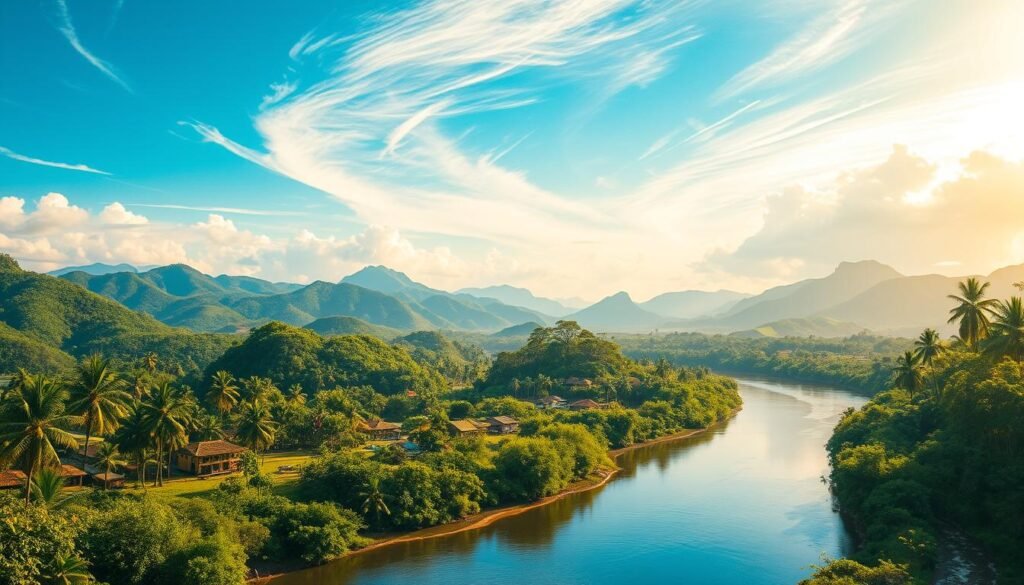
Floodplains, Deltas, and Sediment Deposition
Waterways deposit sediments as they flow, creating fertile floodplains. These areas are rich in nutrients, making them ideal for agriculture. For example, the Nile Delta has supported civilizations for thousands of years.
At the mouth of a river, sediment builds up to form deltas. These landforms are crucial for ecosystems and human settlements. The Mississippi Delta, for instance, is a vital habitat for wildlife and a hub for commerce.
Erosion, Meandering, and Landform Formation
Over time, flowing water erodes rock and soil, carving out valleys and canyons. The Grand Canyon, stretching for miles, is a testament to this powerful process. Erosion shapes the land, creating diverse terrains.
Meandering rivers continuously reshape their paths. As they curve, they deposit sediments on one side while eroding the other. This dynamic process forms unique landforms and habitats.
From the headwaters to the mouth, rivers transform the world around them. Their impact on the landscape is both profound and enduring.
Pre-Colonial River Communities and Societal Development
In the pre-colonial Philippines, communities flourished along freshwater sources, shaping their way of life. These settlements were strategically located near water for agriculture, fishing, and trade. This proximity to water not only ensured survival but also drove socio-economic and cultural advancements.
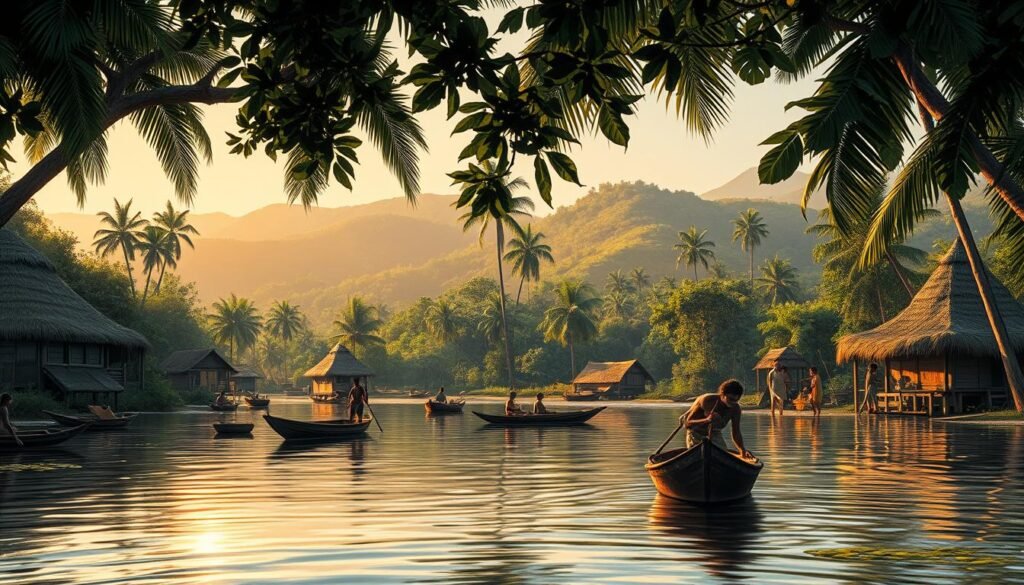
Settlement Patterns along Riversides
Early Filipino communities often settled near water sources like streams and lakes. These locations provided fertile soil for farming and easy access to drinking water. For example, settlements near mountain sources benefited from clean, flowing water.
This strategic placement allowed communities to thrive. They could grow crops like rice and vegetables, ensuring food security. Fishing also became a primary source of protein, supporting a balanced diet.
Socio-Economic Impacts in Early Philippines
Waterways were the lifelines of trade and commerce. Communities exchanged goods like pottery, textiles, and agricultural produce. This network of trade connected barangays, fostering economic growth.
Historically, civilizations like those along the Nile and Indus also relied on water for trade and agriculture. The Nile’s fertile delta supported Egypt’s economy, while the Indus River facilitated commerce in ancient India.
| Civilization | Water Source | Impact |
|---|---|---|
| Ancient Egypt | Nile River | Agriculture, Trade |
| Indus Valley | Indus River | Commerce, Urbanization |
| Pre-Colonial Philippines | Various Waterways | Trade, Agriculture, Settlement |
The interplay between geography and societal development was evident. Natural features like mountain water sources shaped settlement patterns, while waterways fostered economic and cultural exchange. Understanding this dynamic reveals the resilience and ingenuity of early Filipino communities.
Understanding River Ecosystems
River ecosystems are dynamic environments teeming with life, where flora and fauna thrive in harmony with flowing water. These habitats are shaped by the constant movement of water, creating unique conditions for biodiversity. From fast-moving rapids to slow backwaters, each part of a river supports a new array of species adapted to its specific environment.
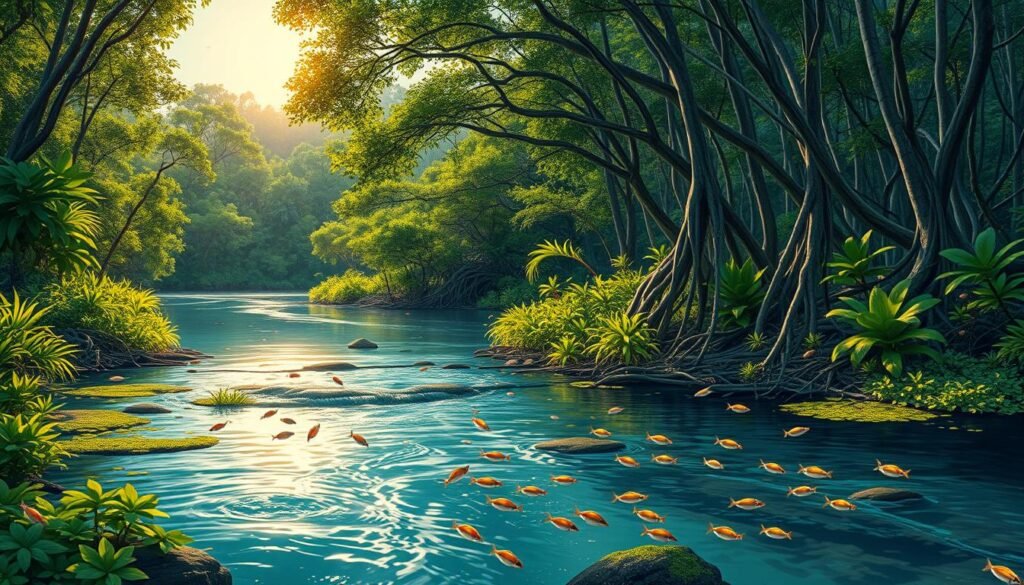
Flora and Fauna in Aquatic Habitats
Aquatic plants and animals have evolved remarkable adaptations to survive in river ecosystems. Algae, for instance, thrive in slow-moving waters, serving as a primary food source for many species. Fish, such as those found in the Nile, have developed the ability to swim against strong currents, ensuring their survival in diverse habitats.
Invertebrates, including insects, play a crucial role in these ecosystems. They inhabit various niches, from the water surface to the riverbed, contributing to nutrient cycling. Water birds, like herons, depend on these invertebrates and fish for sustenance, creating a complex web of life.
The Ecological Significance of River Bends
River bends, or meanders, are vital for habitat formation. They slow down water flow, allowing sediments to deposit and create fertile areas. These bends also provide shelter for species that prefer calmer waters, enhancing biodiversity.
For example, the bends in the Mississippi River support diverse ecosystems, from wetlands to forests. Similarly, in the Philippines, meandering waterways foster unique habitats that sustain local flora and fauna. This dynamic process highlights the importance of preserving natural river courses.
“The health of a river ecosystem is a reflection of its ability to sustain life through its flow and structure.”
Understanding these ecosystems reveals their resilience and the intricate balance between water movement and biodiversity. By studying global examples like the Nile and local waterways, we gain insights into the universal importance of river ecosystems.
Water as a Source of Life and Fertility
From ancient times, water has been the cornerstone of agricultural success, enabling civilizations to flourish. Its role in sustaining life and fertility is undeniable, especially in regions like the hudson basin, where early communities harnessed its power for irrigation. This practice not only supported food production but also shaped the development of societies.
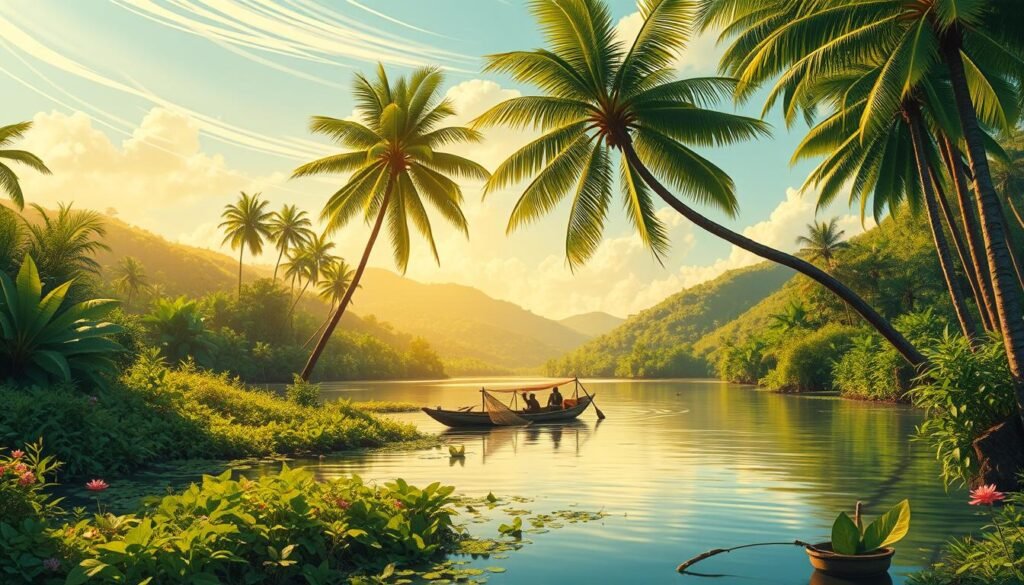
Irrigation and Agricultural Practices
Ancient communities engineered simple yet effective irrigation systems to cultivate fertile lands. By diverting water from natural sources, they ensured consistent crop growth. For example, the Nile Delta in Egypt became a breadbasket due to its advanced irrigation techniques. Similarly, in the Philippines, early settlers used bamboo pipes to channel water to their fields.
From a scientific point of view, water’s role in agriculture is multifaceted. It provides hydration, transports nutrients, and supports photosynthesis. According to scientists, 70% of global freshwater is used for irrigation, highlighting its critical importance. This reliance on water continues today, with modern practices drawing inspiration from ancient knowledge.
“Water is the driving force of all nature.” – Leonardo da Vinci
Historical examples like the Nile Delta demonstrate how irrigation transformed barren lands into fertile fields. This process not only ensured food security but also fostered economic growth. Modern agriculture still relies on these principles, emphasizing the timeless value of water in sustaining life.
| Region | Irrigation System | Impact |
|---|---|---|
| Nile Delta, Egypt | Canals and Dams | Agricultural Boom |
| Pre-Colonial Philippines | Bamboo Pipes | Sustainable Farming |
| Hudson Basin | Natural Diversion | Community Development |
Understanding the historical and scientific significance of water in agriculture reveals its enduring role in shaping civilizations. From the hudson basin to the Nile Delta, water remains a life-sustaining force, driving both ancient and modern agricultural practices.
The Role of Rivers in Pre-Colonial Trade and Commerce (Rivers)
Trade and commerce in the pre-colonial Philippines thrived along natural water routes. These waterways were the arteries of economic activity, connecting communities and fostering cultural exchange. From food to raw materials, goods flowed seamlessly along these channels, shaping the region’s development.
Early Filipino settlements relied heavily on water routes for transportation. Goods like rice, pottery, and textiles were transported efficiently, reducing the need for overland travel. This network of trade linked barangays, creating a thriving economic system. For example, the Pasig and Pampanga rivers were vital hubs for commerce, supporting local economies.
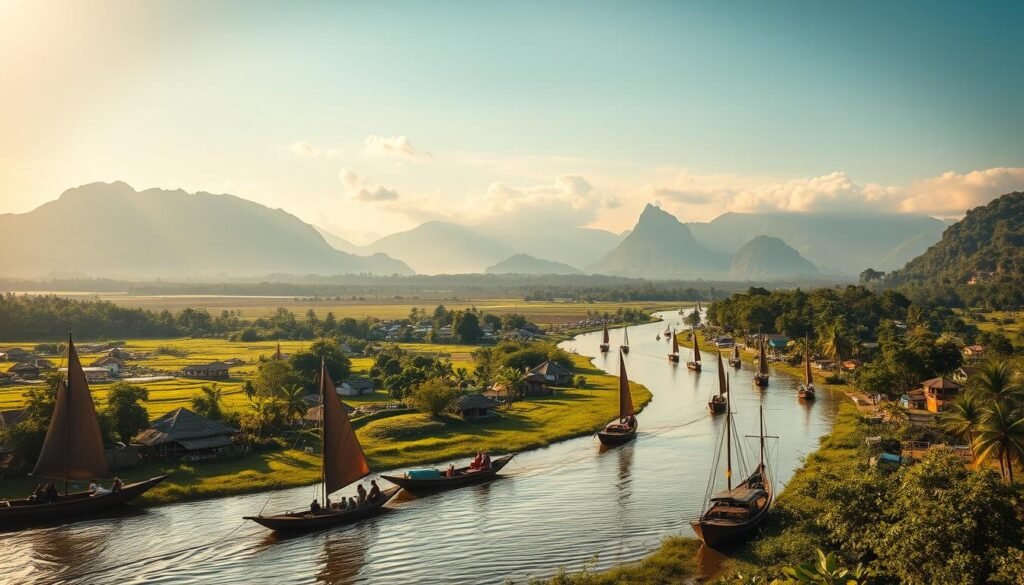
Globally, other regions also leveraged their waterways for trade. In Russia, the Volga River served as a key trade route, connecting the state to distant markets. Similarly, the Ganges in India facilitated the movement of goods like sugar, rice, and silk. These examples highlight the universal importance of water routes in shaping commerce.
The strategic placement of settlements near water sources ensured sustained economic growth. Communities not only traded goods but also exchanged ideas and traditions. This cultural exchange enriched societies, fostering unity and innovation.
“Water routes were the lifelines of pre-colonial trade, connecting people and ideas across vast distances.”
From the Philippines to Russia, waterways played a pivotal role in shaping regional economies. Their influence extended beyond trade, impacting social structures and cultural development. Understanding this legacy reveals the enduring significance of water in human history.
Engineering and Utilization of Waterways
Early civilizations mastered the art of water management to harness the power of natural waterways. These innovations were critical for survival, agriculture, and regional safety. From damming to channelization, ancient societies developed techniques to control river flow and prevent flooding, ensuring stable water supply for their communities.
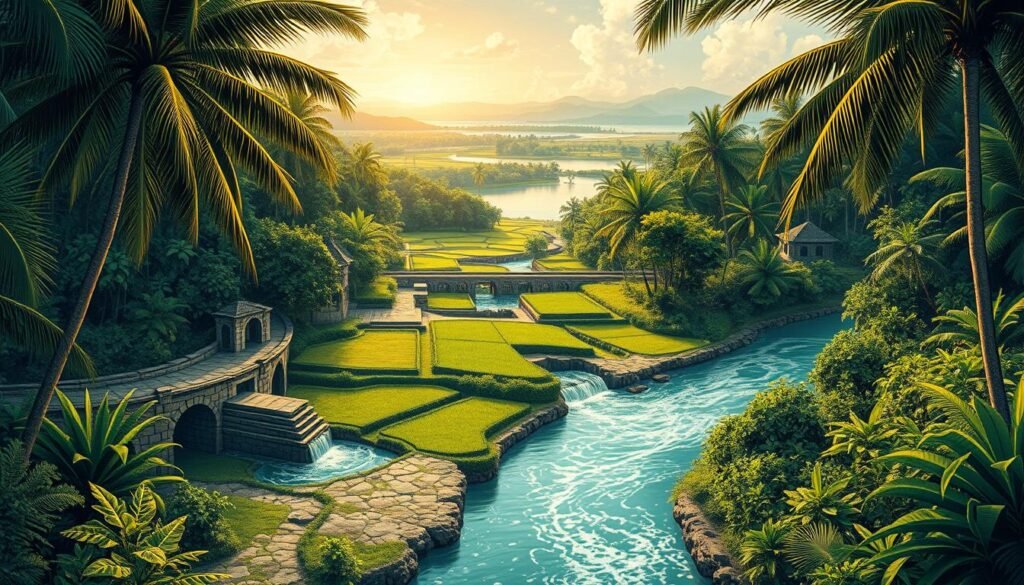
Early Water Management Techniques
Pre-colonial societies engineered solutions to manage water resources effectively. They built rudimentary dams, dredged channels, and levees to control water flow across varying lengths and areas. These structures not only reduced flood risks but also ensured a steady water supply for irrigation and daily use.
For example, ancient Filipinos used bamboo and stone to create simple yet effective irrigation systems. These systems diverted water from natural sources to agricultural fields, supporting crop growth and food security. Similarly, in Mesopotamia, communities constructed canals to manage water distribution across vast areas.
“Water management was the foundation of early societal development, uniting communities in their quest for survival and prosperity.”
Ancient techniques laid the groundwork for modern engineering practices. Today, we continue to build on these innovations, using advanced technology to manage water resources more efficiently. For instance, modern dams and levees are designed to withstand extreme weather conditions, ensuring long-term safety and sustainability.
- Dams were used to store water and regulate river flow.
- Channels were dredged to improve water distribution across large areas.
- Levees were constructed to protect settlements from flooding.
These early efforts highlight the ingenuity of ancient societies in managing water resources. By studying their techniques, we gain valuable insights into sustainable water management practices. To learn more about modern water resource engineering, visit this detailed resource.
Natural Phenomena Shaping River Behavior
The behavior of natural waterways is deeply influenced by seasonal changes and natural phenomena. These forces shape how water flows, where it deposits sediment, and how it impacts surrounding ecosystems. Understanding these dynamics is key to appreciating the role of water in our environment.
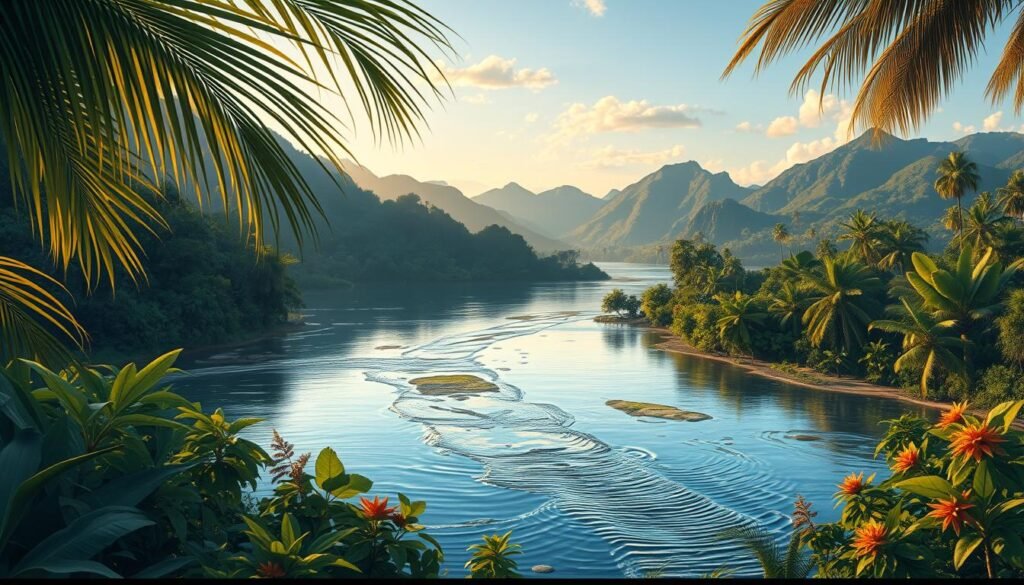
Seasonal Changes and Flooding Cycles
Seasonal variations play a major role in river dynamics. During wet seasons, increased rainfall causes water levels to rise, leading to flooding. This process transports sediment downstream, enriching floodplains and deltas. For example, the Amazon River experiences significant seasonal flooding, which supports its vast biodiversity.
In contrast, dry seasons reduce water flow, exposing riverbeds and slowing sediment transport. These cycles are essential for maintaining the health of river ecosystems. They also impact local agriculture, as farmers rely on predictable flooding patterns for irrigation.
“The cyclical nature of water flow ensures the renewal of ecosystems and the sustainability of human activities.”
Sediment Deposition and River Channels
Sediment deposition is a natural process that shapes river channels and deltas. As water flows, it carries particles of soil and rock. When the flow slows, these particles settle, creating fertile landforms. The Amazon River, for instance, deposits millions of tons of sediment annually, forming its expansive delta.
This process also affects river navigation and flood control. Over time, sediment buildup can alter river courses, requiring human intervention to manage. Understanding these dynamics helps us develop sustainable solutions for water management.
| River System | Seasonal Impact | Key Outcome |
|---|---|---|
| Amazon | Flooding during wet season | Nutrient-rich floodplains |
| Mississippi | Dry season sediment exposure | Altered navigation routes |
| Nile | Annual flooding cycle | Fertile agricultural lands |
Natural phenomena like earthquakes change river courses, further influencing their behavior. These events can block or redirect water flow, leading to sudden changes in sediment deposition and ecosystem dynamics.
By studying these processes, we gain insights into the resilience of river systems and their ability to sustain life. From the Amazon to local waterways, understanding natural phenomena is crucial for preserving these vital resources.
Environmental Challenges and River Conservation
Rivers, once thriving ecosystems, now face unprecedented environmental challenges due to human activities. Pollution, damming, and habitat disruptions have altered their natural flow, threatening both ecosystems and communities. Addressing these issues is crucial for the health of our waterways and the people who depend on them.
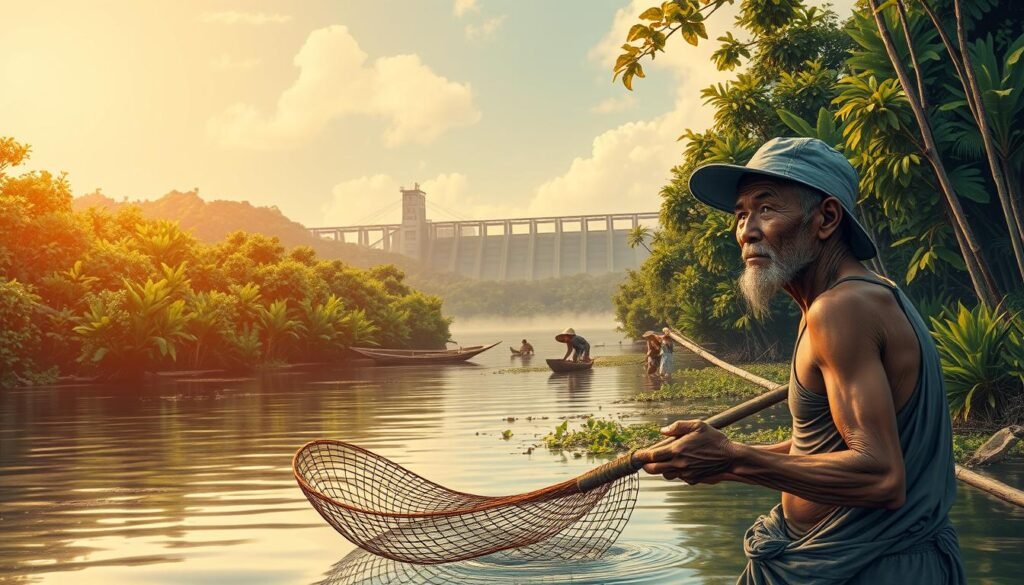
Pollution, Damming, and Habitat Disruptions
Industrial and agricultural runoff has severely polluted many rivers. Chemicals and waste products contaminate water, harming aquatic life and making it unsafe for human use. For example, the Zayandehroud River in Iran has suffered from reduced water quality due to urbanization and industrial development.
Damming has also disrupted natural water flows. While dams provide benefits like flood control and hydroelectric power, they can alter ecosystems. The Zayandehroud Dam, constructed in the 1970s, has significantly impacted the Gavkhooni wetland, reducing its water volume and biodiversity.
Habitat loss is another critical issue. Urbanization and deforestation have destroyed natural habitats along riverbanks. This has led to a decline in species that rely on these ecosystems, such as salmon in the Eel River in California.
Conservation Efforts and Policies
Efforts to restore and protect rivers are gaining momentum. In the United States, over 200 dams have been removed in the last three decades to restore natural water flows. The Benbow Dam removal, for instance, improved access to over 98 miles of high-quality habitat for fish.
The UN has designated 2021-2030 as the decade of ecosystem restoration, emphasizing the importance of rehabilitating polluted waterways. Projects like the Salt River Ecosystem Restoration have successfully restored river channels and salt marshes, benefiting local wildlife and communities.
“The health of our rivers is a reflection of our commitment to preserving the environment for future generations.”
Individuals and communities play a vital role in river conservation. Simple actions like reducing waste, supporting local conservation groups, and advocating for policy changes can make a significant impact. By working together, we can ensure the health and sustainability of our waterways.
For more insights on how to protect endangered rivers, visit this detailed resource.
Comparative Insights: Global and Local River Histories
From the Mississippi to the Pasig, waterways have played a pivotal role in human history. These natural lifelines have shaped civilizations, economies, and ecosystems across the earth. By comparing global examples like the Colorado and local Philippine waterways, we uncover both shared traits and unique regional characteristics.
Global River Examples Versus Philippine Waterways
The Mississippi River, one of the world’s longest, has shaped the American landscape through sediment deposition and floodplain formation. Similarly, the Cagayan River in the Philippines has created fertile valleys, supporting agriculture and communities. Both rivers demonstrate how waterways influence settlement patterns and economic growth.
In the earth’s diverse terrains, rivers like the Colorado have carved iconic landmarks such as the Grand Canyon. This process of erosion and landform creation is mirrored in the Philippines, where the Chico River has shaped mountainous regions. These examples highlight the universal power of flowing water in shaping landscapes.
Cultural contexts also play a role. The Ganges in India is revered as sacred, while the Pasig River in the Philippines was a vital trade route in pre-colonial times. These differences underscore how geography and culture influence the development of river civilizations.
“Rivers are the veins of the earth, carrying life and history through their currents.”
Understanding these comparisons reveals the universal importance of waterways in nurturing human life and ecosystems. From the Mississippi to local Philippine rivers, their stories remind us of our shared dependence on these vital resources. For more insights into the significance of waterways, explore this detailed resource.
Lessons from Pre-Colonial Philippines’ Water Management
The pre-colonial Philippines offers timeless lessons in water management that remain relevant today. Early communities developed innovative techniques to harness and preserve water, ensuring their survival and prosperity. These practices not only fostered resilience but also laid the foundation for sustainable development.
Traditional Practices and Community Resilience
Pre-colonial Filipinos mastered the art of water management using simple yet effective methods. Bamboo pipes and stone channels were used to divert water from natural sources to agricultural fields. This ensured a steady flow of water for irrigation, supporting crop growth and food security.
Communities also built rudimentary dams and levees to control water flow and prevent flooding. These structures were crucial for protecting settlements and maintaining stable water supplies. For example, the Prinza Dam, constructed in the 18th century, played a significant role in irrigating rice fields in Las Piñas and Bacoor.
These traditional practices fostered resilience in the face of natural challenges. By working together, communities ensured that water resources were managed sustainably, benefiting everyone. This collaborative approach remains a valuable lesson for modern water management.
Modern Relevance and Sustainability Insights
Many of the techniques used by pre-colonial Filipinos are still relevant today. Modern irrigation systems often draw inspiration from ancient methods, emphasizing efficiency and sustainability. For instance, the use of bamboo pipes has evolved into advanced piping systems that reduce water waste.
Current conservation efforts can also learn from traditional practices. Early communities understood the importance of maintaining a balance between water use and preservation. This principle is now a cornerstone of sustainable development, guiding policies to prevent overexploitation of water resources.
“The wisdom of our ancestors in managing water resources continues to inspire modern solutions for a sustainable future.”
By studying these historical practices, we can develop strategies that address today’s environmental challenges. For example, integrating traditional knowledge with modern technology can enhance flood control and water conservation efforts. To learn more about the evolution of water management in the Philippines, visit this detailed resource.
Understanding the lessons from pre-colonial water management reveals the ingenuity and resilience of early Filipino communities. Their practices not only ensured survival but also fostered sustainable development, offering valuable insights for the present and future.
Conclusion
Throughout history, natural waterways have been the lifeblood of civilizations, shaping their growth and survival. In the pre-colonial Philippines, these lifelines were central to the development of communities, providing resources, fostering trade, and uniting cultures. From the fertile plains nourished by seasonal floods to the majestic waterfalls that symbolized nature’s power, water was more than a resource—it was a way of life.
Early settlements thrived along these waterways, leveraging their natural processes for agriculture and transportation. The steady flow of water supported crops like rice, while the plains created by sediment deposition became hubs for trade and cultural exchange. These practices laid the foundation for societal resilience and innovation.
Ancient engineering techniques, such as bamboo irrigation systems and rudimentary dams, highlight the ingenuity of early Filipinos. These methods ensured a sustainable water supply, even during challenging times. Today, these practices inspire modern conservation efforts, reminding us of the importance of preserving our natural heritage.
As we reflect on the past, it’s clear that the health of our waterways is essential for the future. Protecting these resources ensures the sustainability of ecosystems and communities alike. By appreciating the lessons of history, we can foster a deeper connection to our environment and work toward a more sustainable future.
“The legacy of our ancestors’ water management practices continues to guide us in preserving the lifeblood of our planet.”
| Key Aspect | Role in Pre-Colonial Philippines |
|---|---|
| Agriculture | Supported crop growth through irrigation and fertile plains |
| Trade | Facilitated the exchange of goods and ideas |
| Culture | Fostered unity and spiritual connections |
| Engineering | Innovative water management techniques ensured sustainability |
For further insights into the interconnectedness of river systems and their impact on communities, explore this detailed resource. Let us honor the legacy of these waterways by committing to their conservation and sustainable use.
References & Further Reading
Understanding the power of water in shaping civilizations requires exploring credible sources. Below is a curated list of references and further readings to deepen your knowledge on the subject.
For insights into river ecosystems and their historical significance, consider The River Project’s Further Reading. This resource offers a comprehensive look at water management and its impact on societies.
Studies like those by Alexander and Smith (2006) provide valuable data on nutrient enrichment in U.S. waterways. Similarly, research by Bennett et al. (2001) highlights global human impacts on phosphorus and eutrophication, offering a broader perspective.
For those interested in India’s water systems, the Brisbane Declaration (2018) emphasizes the social and cultural dimensions of environmental flows. This document is essential for understanding the balance between human needs and ecosystem health.
To explore more about sustainable water practices, the Sustainable Development Goals (SDG6) focus on water management and sanitation. These goals are crucial for ensuring the life and well-being of communities worldwide.
By delving into these resources, you can gain a deeper appreciation for the role of water in history, culture, and modern sustainability efforts.
FAQ
How did rivers shape pre-colonial Philippine culture?
Rivers played a vital role in trade, transportation, and spiritual practices, connecting communities and fostering cultural identity.
What are the key geographical features of a river?
A river typically starts at a source, flows through a course, and ends at a mouth, often forming deltas or floodplains along the way.
How did rivers influence early settlement patterns?
Communities settled near rivers for access to water, fertile land, and transportation, which supported agriculture and trade.
What role did rivers play in pre-colonial trade?
Rivers served as natural highways, enabling the movement of goods like rice, pottery, and textiles between communities.
How did early societies manage water resources?
They used techniques like irrigation and water diversion to support farming and sustain their livelihoods.
What challenges do rivers face today?
Pollution, damming, and habitat destruction threaten river ecosystems, impacting both wildlife and human communities.
How do global rivers compare to those in the Philippines?
While rivers like the Nile and Amazon are larger, Philippine waterways share similar roles in shaping culture, trade, and ecology.
What can we learn from pre-colonial water management?
Traditional practices highlight the importance of community resilience and sustainable resource use, offering insights for modern conservation.
Source Links
- Historical Overview · The Philippines and the University of Michigan, 1870-1935 · Philippines
- Precolonial barangay
- Understanding Rivers
- River Valley Civilizations | World Civilization
- Rivers and Their Cultural Values: Assessing Cultural Water Requirements
- Rivers, Streams, and Creeks
- 2.1 River Features
- Explore rivers – BBC Bitesize
- Rivers and the Landscape
- River – Landscape Evolution, Erosion, Transport | Britannica
- Rivers and Streams: Life in Flowing Water
- Sacred Rivers: Religion and Development in Northern India — The Cornell Diplomat
- Pre-colonial history of the Democratic Republic of the Congo
- River ecosystems
- River ecosystem
- Mountains and freshwater supply
- beddig
- No title found
- Canals and inland waterways | Description, History, Types, Features, Importance, & Examples | Britannica
- Role of engineering in sustainable water management – Earth Perspectives
- Rivers and Streams – Water and Sediment in Motion
- River
- Ecological-environmental challenges and restoration of aquatic ecosystems of the Middle-Eastern – Scientific Reports
- River Habitat
- Rivers As International Borders: A Comparison of How Social-Political Factors Have Impacted Natural Resources in the Usumacinta River Basin and Rio Grande River Basin Within the Context of Climate Change
- Guest Editors’ Introduction to Issue Eight
- Microsoft Word – phil.doc
- Rivers: A Reflection of Life
- Cambridge Quaternary, Cambridge » History of the major rivers of southern Britain during the Tertiary
- References | Mississippi River Water Quality and the Clean Water Act: Progress, Challenges, and Opportunities
- Understanding rivers and their social relations: A critical step to advance environmental water management

